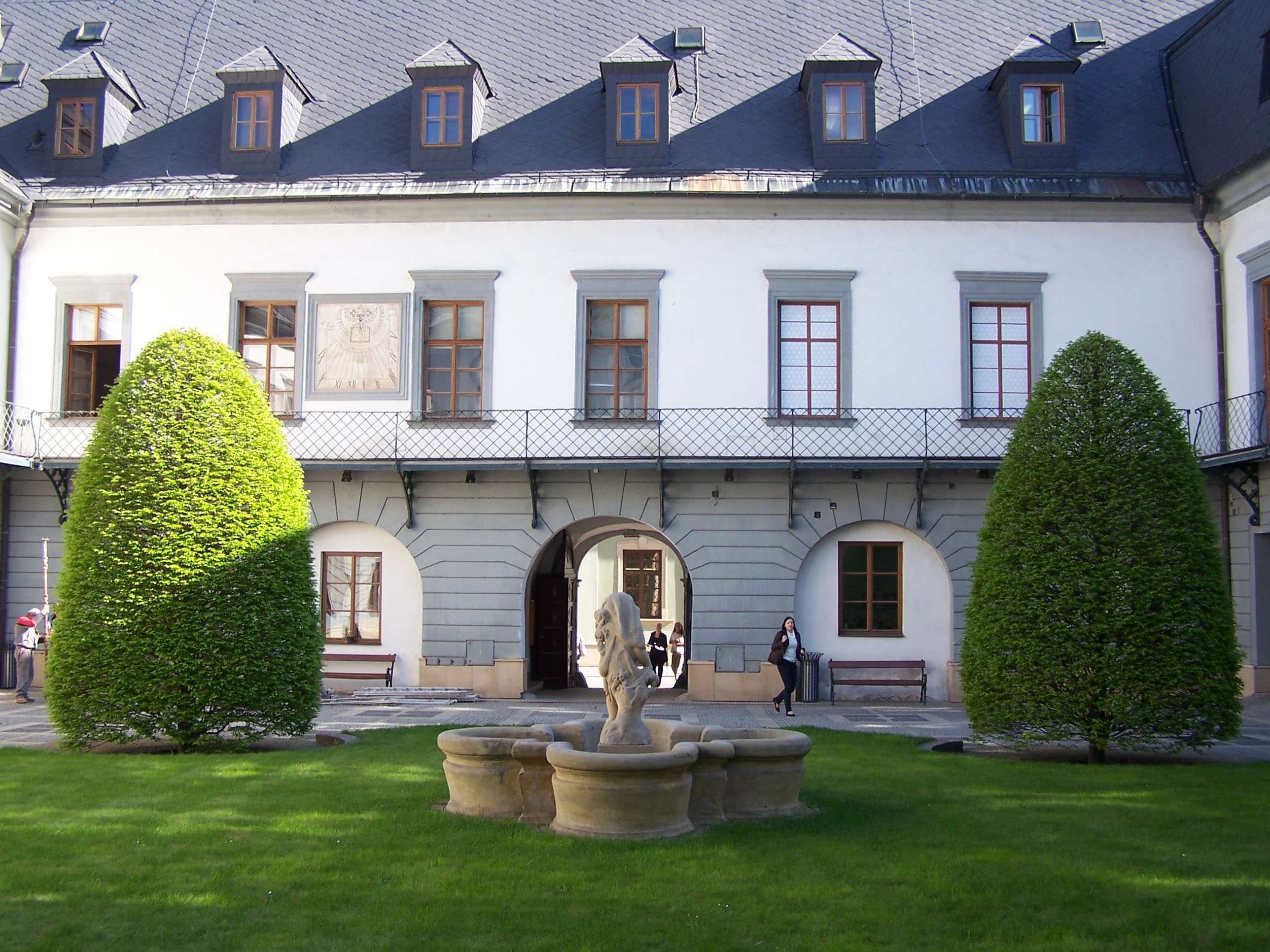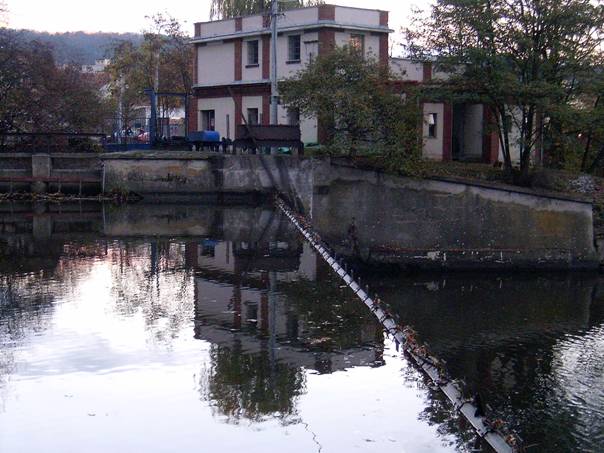|
Jimramov
Jimramov (german: Ingrowitz) is a market town in Žďár nad Sázavou District in the Vysočina Region of the Czech Republic. It has about 1,100 inhabitants. The historic town centre is well preserved and is protected by law as an urban monument zone. Administrative parts Villages of Benátky, Sedliště, Trhonice and Ubušín are administrative parts of Jimramov. Geography Jimramov is located about east of Žďár nad Sázavou and northwest of Brno. It lies in the Upper Svratka Highlands, on the border of the Žďárské vrchy Protected Landscape Area. The Svratka river flows through Jimramov. History The first written mention of Jimramov is from 1361. A fortress in Jimramov is documented in 1392. In 1537, Jimramov was promoted to a market town by King Ferdinand I. Until 1588, the estate was owned by the Pernštejn family, who sold it to Pavel Katharin of Kathar. This nobleman chose Jimramov as his seat and had the town hall and a castle built here. Jimramov reached the ... [...More Info...] [...Related Items...] OR: [Wikipedia] [Google] [Baidu] |
Karel Slavíček
Karel Slavíček, (), (12 December 1678 – 24 September 1735) was a Jesuit missionary and scientist, the first Czech sinologist and author of the first precise map of Beijing. Biography Early life and studies in the Czech lands Karel Slavíček was born in a house called cs, U Slunce ("By the Sun") on the main square in Jimramov, a small town straddling the historical border between Bohemia and Moravia. His father, Václav Vojtěch Slavíček, was a teacher and town councillor writer. After finishing Gymnasium (school) in Brno, Slavíček entered the Jesuit order as a novice in 1694. Later he studied at Faculty of Philosophy and Faculty of Theology of Olomouc University. After finishing his studies, he stayed at the University as a teacher of mathematics and Hebrew language and history. Later he went to Prague, where he studied Theology at Charles University. He was ordained as a priest in 1707. Astronomy soon became his hobby. During his studies in Prague Slav� ... [...More Info...] [...Related Items...] OR: [Wikipedia] [Google] [Baidu] |
Žďár Nad Sázavou District
Žďár nad Sázavou District ( cs, okres Žďár nad Sázavou) is a district ('' okres'') within the Vysočina Region of the Czech Republic. Its administrative center is the town of Žďár nad Sázavou. Landscape The district's landscape is very picturesque, consisting of a highland of rolling hills around the rivers Sázava, Oslava, Svratka and Chrudimka, covered by deep forests, lakes and fields. Economy 37% of the active population works in industry. Agriculture is also an important economic activity, especially wheat, potatoes, fruit, timber, and livestock. The contribution of industry and agriculture to the local economy has decreased markedly since 1991. The remaining industrial activity is concentrated in the larger towns and includes mechanic, electric, and steel factories. Furniture and other small manufacturing industries have been installed after the fall of Communism. Tourism The area, relatively untouched by pollution, attracts summer and winter tourism. Highli ... [...More Info...] [...Related Items...] OR: [Wikipedia] [Google] [Baidu] |
Vilém Mrštík
Vilém Mrštík (; 14 May 1863 in Jimramov – 2 March 1912 in Diváky) was a Czech writer and dramatist. Career He is known for his novel ''Santa Lucia'' (1893). With his brother, Alois (1861–1925) he also wrote the drama '' Maryša'' (1894). This play, set in rural Moravia, explored gender roles and tradition in a small village. In contrast to the more positive renderings of rural life by the writers of the National Revival, the brothers attempted a more impartial view of life in the countryside. He is also famous for having fought against the mass destruction of historic buildings carried out as part of urban renewal plans for parts of Prague Prague ( ; cs, Praha ; german: Prag, ; la, Praga) is the capital and List of cities in the Czech Republic, largest city in the Czech Republic, and the historical capital of Bohemia. On the Vltava river, Prague is home to about 1.3 milli ... by publishing two influential essays: Manifest to the Czech People (1896), and ''Be ... [...More Info...] [...Related Items...] OR: [Wikipedia] [Google] [Baidu] |
Jan Karafiát (author)
Jan Karafiát (4 January 1846 – 31 January 1929) was a Czechs, Czech clergyman of the Evangelical Church of Czech Brethren and author. He is best known for his classic children's book ''Broučci'', the Czech language word for Fireflies, that was first published in the early 1870s. Traditional Czech figurines of fairylike insect peopleRaul A. Barrenech3 friends transform a Czech getawayArts & Leisure September 15, 2006 International Herald Tribune] are based on the characters in the book. He is also known for his poetry, which often reflected his religious beliefs, additionally he was one of the reviewers of Bible of Kralice – the first Czech protestant translation of the Bible. Life Karafiát was born to a noble family in Jimramov in 1846. He went to school at Gütersloh. He studied theology in Litomyšl, Berlin (1866–1867), Bonn (1867–1868), Vienna (1866–1869) and Edinburgh (1871–1872). He became Vicar at Roudnice nad Labem and in 1874 an administrator of the Protestan ... [...More Info...] [...Related Items...] OR: [Wikipedia] [Google] [Baidu] |
Count Richard Belcredi
Count Richard von Belcredi (german: Richard Graf Belcredi; 12 February 1823 – 2 December 1902) was an Austrian civil servant and statesman, who served as Minister-President (and 'Minister of State') of the Austrian Empire from 1865 to 1867. During 1881–1895, Belcredi was President of the Cisleithanian Administrative Court. Life Richard Graf von Belcredi was born on 12 February 1823, in Jimramov (Ingrowitz), in the Margraviate of Moravia, the youngest son of Count Eduard von Belcredi (1786–1838) and his wife Countess Maria von Fünfkirchen (1790–1860). He had one sister, Countess Almeria (1819-1914), who married Prince Hugo Maximilian von Thurn und Taxis (817-1889). The Belcredi noble family originally descended from Lombardy, where they had been vested with the estates of Montalto Pavese by the Sforza dukes of Milan. Count Richard's ancestors settled in Moravia from 1769 onwards. He studied law at the universities of Prague and Vienna; in 1854, he was appointed district ... [...More Info...] [...Related Items...] OR: [Wikipedia] [Google] [Baidu] |
Městys
Městys (or, unofficially or obsolete, městečko (literally "small town")), translated as "market town", is a status conferred on certain municipalities in the Czech Republic, lying in terms of size and importance higher than that of simple ''obec'' (municipality), but lower than that of ''město'' (city, town). Historically a ''městys'' was a locality which had the right to stage livestock markets (and some other "extraordinary" and annual markets), and it is therefore translated as "market town". The term went out of official use in Czechoslovakia in 1954, but was reintroduced in the Czech Republic in 2006. As of September 2020, there are 228 municipalities on which the status of ''městys'' has been re-admitted. In all cases, these are municipalities that have requested the return of their former title. This title has not been newly awarded to any municipality that would not have it in the past, the law does not even set any specific criteria for it, only procedural competenc ... [...More Info...] [...Related Items...] OR: [Wikipedia] [Google] [Baidu] |
Svratka (river)
The Svratka (), formerly ''Švarcava'' (german: Schwarzach) is a river in the South Moravian Region of the Czech Republic. It is long, and its basin area is . It rises in the Bohemian-Moravian Highlands, converges with the Svitava in Brno, and flows into the Dyje (''Thaya'') a near Mikulov. The river is known in the local Moravian dialect as the ''Švarcava'' (from the German German(s) may refer to: * Germany (of or related to) ** Germania (historical use) * Germans, citizens of Germany, people of German ancestry, or native speakers of the German language ** For citizens of Germany, see also German nationality law **Ge ... name of the river ''Schwarzach''). References Rivers of the Vysočina Region Rivers of the South Moravian Region Břeclav District Žďár nad Sázavou District {{CzechRepublic-river-stub ... [...More Info...] [...Related Items...] OR: [Wikipedia] [Google] [Baidu] |
Meyrargues
Meyrargues (; oc, Mairarga) is a commune in the Bouches-du-Rhône department in southern France. Population Personalities *Writer Joseph d'Arbaud was born in Meyrargues. *Raouia Rouabhia - Algerian international volleyball player See also *Communes of the Bouches-du-Rhône department The following is a list of the 119 communes of the Bouches-du-Rhône department of France. The communes cooperate in the following intercommunalities (as of 2020):Communes of Bouches-du-Rhône Bouches-du-Rhône communes a ... [...More Info...] [...Related Items...] OR: [Wikipedia] [Google] [Baidu] |
Sister City
A sister city or a twin town relationship is a form of legal or social agreement between two geographically and politically distinct localities for the purpose of promoting cultural and commercial ties. While there are early examples of international links between municipalities akin to what are known as sister cities or twin towns today dating back to the 9th century, the modern concept was first established and adopted worldwide during World War II. Origins of the modern concept The modern concept of town twinning has its roots in the Second World War. More specifically, it was inspired by the bombing of Coventry on 14 November 1940, known as the Coventry Blitz. First conceived by the then Mayor of Coventry, Alfred Robert Grindlay, culminating in his renowned telegram to the people of Stalingrad (now Volgograd) in 1942, the idea emerged as a way of establishing solidarity links between cities in allied countries that went through similar devastating events. The comradesh ... [...More Info...] [...Related Items...] OR: [Wikipedia] [Google] [Baidu] |
Alois Mrštík
Alois (Latinized ''Aloysius'') is an Old Occitan form of the name Louis. Modern variants include ''Aloïs'' ( French), ''Aloys'' (German), ''Alois'' (Czech), ''Alojz'' ( Slovak, Slovenian), '' Alojzy'' (Polish), '' Aloísio'' (Portuguese, Spanish, Italian), and '' Alajos'' ( Hungarian). People called Alois/Aloys * Alois Alzheimer (1864–1915), German psychiatrist and neuropathologist * Alois Arnegger (1879–1963), Austrian painter * Alois Biach (1849–1918), Austrian physician and medical writer * Alois Brunner (1912–2001), Austrian Nazi SS concentration camp war criminal * Alois Carigiet (1902–1985), Swiss illustrator * Alois Dryák (1872–1932), Czech architect * Alois Eliáš (1890–1942), Czech general and politician * Alois Estermann, senior officer of the Pontifical Swiss Guard who was murdered in his apartment * Alois Hába, Czech composer * Alois Hitler (1837–1903), born Aloys Schicklgruber; Adolf Hitler's father * Alois Hitler, Jr. (1882–1956), Adolf Hitle ... [...More Info...] [...Related Items...] OR: [Wikipedia] [Google] [Baidu] |
Pernštejn Family
The Pernštejn (german: Pernstein) was one of the seven Moravian dynasty families and the most important (uradel) family originating from Moravian nobility. The first mentioned member of House of Pernštejn lived in the 13th century. They took their name after their first main seat – the Pernštejn Castle. Throughout history, Pernštejns held some of the most prestigious offices in both Kingdom of Bohemia and Margraviate of Moravia. Four members of the House of Pernštejn were appointed to the position of Land Hejtman of Moravia at various times. Their power peaked in the 16th century during the life of Vilém II of Pernštejn and his sons. With John Vratislav of Pernštejn the male line of the family became extinct in 1631. The last member of the female line – Polyxena of Pernštejn – then married into the House of Lobkowicz, who incorporated the black aurochs of Pernštejn family into their coat of arms. One of the most important authorities on the Pernstejn family histo ... [...More Info...] [...Related Items...] OR: [Wikipedia] [Google] [Baidu] |


.jpg)
